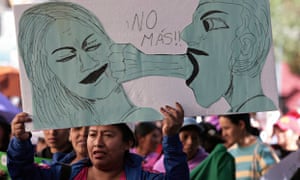Author: Anna Woodworth
Co-Authors: Mishelle Perez Gonzalez, Leah Jacob, and Ravi Musalin
Violence Against Women: A Snapshot
From January 1st to January 30th of this year, there have been six registered femicides in Paraguay. Lawmaker Rocio Casco, head of the legislative commission of Equity and Gender in Paraguay, recently stated that violence against women in Paraguay has risen 32% from 2015 to 2016. According to a report from the Attention Service for Women of the Women’s Secretariat, the number of cases of violence against women in the Southern Cone country have increased from 420 in the year 2000 to 1390 in 2007 to October. Amidst a nation of massive political and class divide following a 35 year dictatorship, there is little institutional aid for the women of Paraguay in the face of violence and inequality.
Women’s Reproductive Rights

The sign reads: “You’ll forget it, me, I will remember it for the rest of my life,’ at a demonstration regarding sexual abuse in front of the attorney general’s office in Paraguay. Courtesy of the Associated Press.
Lawmakers of the landlocked country have recently scrapped a bill which would address gender violence. In a country where abortion is not legal, this bill would have allowed women suffering from the results of an unsafe abortion to seek free medical help without being reprimanded. According to Miriam Gonzalez, a member of the group Paraguay Coordination for Women, “a quarter of women’s deaths in the country are due to consequences of unsafe abortions.” Another staggering statistic states that over 1 in 20 girls in Paraguay under the age of 20 have given birth; in rural areas of Paraguay, this age lowers, such as in the Atlantic forest where a quarter of these girls are aged 14 or younger. These data suggest that reproductive rights beyond contraception and sex education may be beneficial for Paraguayan women: currently, abortion is illegal unless the mother’s life is at risk; this may be attributed to the country’s predominantly Catholic demographic.
In early 2015, a story came to light of a 10-year old Paraguayan girl who was raped and impregnated by her stepfather. At 5 months pregnant, she and her mother, also supported by Amnesty International, asked the government to be allowed an abortion. Health Minister Antonio Barrios, however, denied her request for abortion, stating that “there is no indication that the health of the [girl] is at risk … therefore we are not, from any point of view, in favor of the termination of the pregnancy.” The girl’s mother was later arrested for failing to protect her daughter from her rapist. The girl gave birth in August of that year by cesarean, and she and her baby were reported to be healthy. This fortunate outcome is in contrast with the estimated 70,000 young girls who die each year from complications of pregnancy or childbirth. This story is further explained in the video above.
Equal Land Ownership for Women

Women outside the Agriculture Ministry and the Rural Development and Land Institution in Asuncion. Courtesy of the Latin American Herald Tribune.
Land, as a dividing factor amongst many Paraguayans, is unsurprisingly also a major issue for the women of Paraguay. On March 8th of this year, International Women’s Day, women of rural Paraguay participated in a demonstration outside of the Agriculture Ministry and Rural Development and Land Institute in the city of Asuncion. Concepcion Meza, a San Pedro province farmer, stated that women are not recognized as food producers and are not granted land titles as men are by government agencies. This unequal distribution of land contributes to the class inequality between rural and urban Paraguayans while targeting indigenous, rural Paraguayan women who have little access to other means of income or subsistence compared to their urban counterparts.
Summary Factoids
- When is abortion legal in Paraguay? When the mother’s life is at risk.
- How many femicides occurred in January of 2017 in Paraguay? Six.
- Why did women protest outside of the Agriculture Ministry and Rural Development and Land Institute in Asuncion? The government doesn’t recognize them as food producers and they are not granted land titles.
Citations
Carneri, Santi. “The battle to end unbridled discrimination in Paraguay.” Equal Times. Equal Times, 22 Feb. 2017. Web. 12 Mar. 2017.
Hanna, Jason, and Rafael Romo. “Paraguay man arrested in rape of girl, 10, who became pregnant.” CNN World. Cable News Network Turner Broadcasting System, 10 May 2015. Web. 11 Mar. 2017.
Hill, Toby Sterling. “Generation of hope: the girls challenging misogyny in the heart of rural Paraguay.” The Guardian. Guardian News and Media Limited , 24 Oct. 2016. Web. 11 Mar. 2017.
Latin American Herald Tribune. “Women Demand Equal Land Ownership Rights in Paraguay.” Latin American Herald Tribune. Latin American Herald Tribune, 8 Mar. 2017. Web. 11 Mar. 2017.
TeleSUR. “Paraguay’s Congressman Gut Gender Violence Bill.” TeleSUR. La nueva Televisión del Sur C.A. , 10 Aug. 2016. Web. 12 Mar. 2017.
United Nations Population Fund (UNFPA). “Paraguay: Country Assessment on Violence Against Women.” United Nations Population Fund (UNFPA) (2008): 1-56. 25 Nov. 2008. Web. 10 Mar. 2017.





